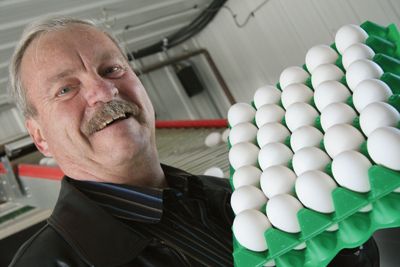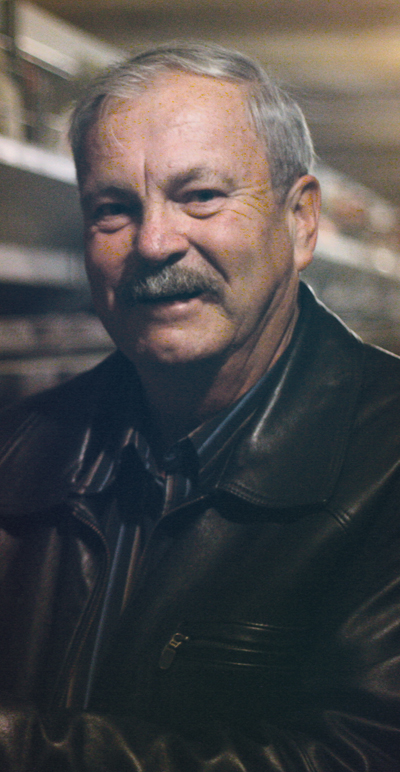
Laurent Souligny has now been the president of Egg Farmers of Canada (EFC) for 10 years. At 65, retiring doesn’t even cross his mind. “Friends are suggesting I call it quits and come and play golf with them. I tell them I already feel like I’m retired, because I really enjoy what I do.”
Laurent Souligny has now been the president of Egg Farmers of Canada (EFC) for 10 years. At 65, retiring doesn’t even cross his mind. “Friends are suggesting I call it quits and come and play golf with them. I tell them I already feel like I’m retired, because I really enjoy what I do.”

|
| EFC Chair Laurent Souligny says that the EFC have predicted a 1.5 per cent increase in consumption for 2009. But numbers from the first months of the year show the increase might be higher than expected.
|
Souligny became involved with the industry only a few years after acquiring his first layers, in 1983. Back then, he and his wife Hélène, along with son Jean and daughter Guylaine, were operating a dairy farm in Moose Creek, in eastern Ontario.
The family started its poultry operation in nearby St-Isidore. Nine years later, the dairy farm was sold. Egg production would be less labour intensive and more in tune with Jean’s interests.
 |
|
| Laurent Souligny says “I love the poultry business and its people. I get involved because I enjoy it and I want to serve the industry.” |
Today, the family’s 20,000 layers and 1250 acres are mostly managed by Jean. This allows Laurent to spend all the required time away in meetings and at EFC promotional events.
When Canadian Poultry Magazine met Laurent last April, he had just returned from Ottawa, where EFC were awarding prizes to 22 finalists at the Canwest Canspell National Spelling Bee. “It’s really important to participate in such events,” he said. “Children are tomorrow’s consumers. We also know that those who eat eggs in the morning are more focused in school.”
Souligny was first elected to the board of director of Egg Farmers of Ontario (EFO) in 1987, as the representative of Region 10 (Counties of Prescott, Russell, Glengarry and Stormont). He became part of EFO’s executive in 1989.
After sitting at the national board for a few years during the mid-90s, Souligny was elected in 2000 president of the Canadian Egg Marketing Agency (CEMA), which became EFC in August last year.
Presiding a national farmers’ organization is all about bringing people from all provinces together, Souligny says.
EFC are “like a big family,” he says. But siblings don’t always get along and getting 15 board members to agree is a challenge.
“Sometimes I tell my board: I don’t have too much trouble getting you to sit in the same boat, but I find it hard getting you all to row in the same direction!”
New quota allocations are often a source of tension between provinces. Since the early 2000s, Saskatchewan had been fighting for a larger share of above-the-base new quota. The province appealed every decision. Recently, producers came to an agreement that satisfied both Saskatchewan and the other provinces.
“For the first time in several years, our last allocation (in March) was approved unanimously,” Souligny said.
Souligny is not the type of person to take the credit for EFC’s successes. However, he reckons that being a bilingual Francophone from Ontario does help improve dialogue between provinces.
People in Quebec are different, Souligny says. “Sometimes, they are not understood outside their province, but I understand them very well.”
When Souligny first took over EFC’s leadership, Quebec egg producers were withholding their levies for transformation eggs. They claimed they were contributing too much to these equalization payments that are used to compensate farmers whose eggs head for transformation rather than retail.
A special committee was set up, a solution was found and the withheld funds were paid. According to Souligny, there has been no problem with Quebec since then.
Souligny says he’s now considering his position with EFC “one year at a time.” There are a lot of younger farmers who could do a good job if they replaced him, but many are busy raising their children and making their farms grow.
Being the president of EFC does take a lot of time, sometimes very far away from the farm, Souligny says. But until this becomes a burden, he still wants to be at the forefront of the battles the poultry industry needs to fight.
This includes constant lobbying for the survival of supply management. The Harper government is committed to preserving farm quotas, but Souligny fears Canada’s position could suddenly change if a compromise is accepted to reach a deal at the last hour at World Trade Organization talks.
If supply management is to continue, Souligny believes poultry farms must remain family businesses. Otherwise, farmers’ political weight will dwindle away.
Canadian family-operated layer farms can be just as efficient as large-scale corporate farms in the United States, Souligny says. Layers in Canada give an average of 24.9 dozens of eggs per year. This average is bond to increase in 2010, when the results of the current cost-of-production survey are published.
Souligny also wants to keep lobbying the federal government for better compensations when avian influenza strikes again. Officials in Ottawa say existing programs would compensate farmers, but EFC’s analysis of programs shows some farmers would be left with no compensation at all.
As a personal challenge, Souligny would like to change the way prices are set for transformation eggs. The historic reasons behind the lower prices paid by industrial users no longer apply to today’s reality, he says.
"Before leaving my position with EFC, I would like to strike a deal with industrial users that wouldn’t have to be re-negociated every year,” Souligny said.
In the meantime, egg farmers can rejoice over Canada’s steady increase in egg consumption. In 2008, Canadians bought four per cent more eggs.
EFC have predicted a 1.5 per cent increase in consumption for 2009. But numbers from the first months of the year show the increase might be higher than expected. In tough economic times, eggs are an affordable source of protein, Souligny says.
Between last November and March, quota for 500,000 new layers was allocated, in order to respond to a strong demand. Such a sharp increase was “never before seen!” said Souligny.
Print this page